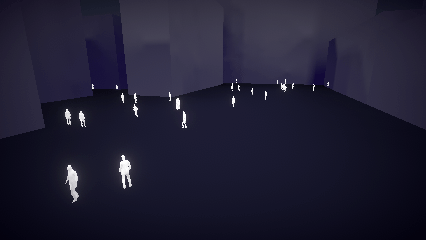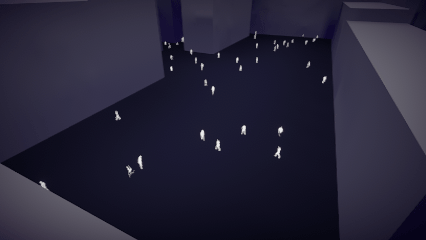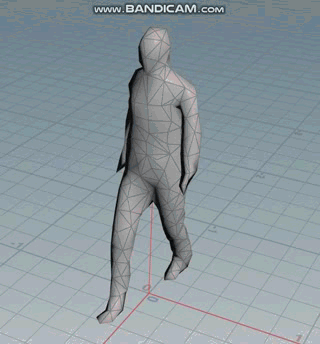Unity ECS, Swarm Animation and Markov Chain| ECS集群动画与马尔可夫链
Nov 24, 2018
Github Codebase


交通模拟的项目,要添加大量的行人,自然想到的肯定要用animation instancing。其主要思路是把骨骼动画烘焙成贴图,skinning状态是per instance的,在vertex shader中读取animation texture做skinning运算。笔者这里有几点不同。
- 视角更远,甚至都没必要做骨骼蒙皮,直接用顶点动画即可
- 动画状态机没有gameplay逻辑,是一个随机过程就好
UnityAustinTechnicalPresentation提供了一个ECS的集群动画案例,虽然其代码已经编译不出来了,但是通过阅读源码可以了解其大致逻辑
- 启动时将骨骼动画数据烘焙成动画贴图
- gameplay逻辑中更新状态ID,这部分相当于hardcode的状态机。Job里面目测没法反射或者模板,animator自然是不能用了。Hardcode状态机是不太好维护了。
- per instance数据更新进NativeArray,直接就可以转成ComputeBuffer,然后DrawMeshInstancedIndirect
做法基本遵循了Animation Instancing的方法。
笔者这里的方法是:
- 使用Houdini预先烘焙顶点动画贴图
- 使用转移矩阵控制动画状态切换,即Markov Chain,使用Job并行更新状态
- DrawMeshInstance
这样主要优点是
- shader运算量更小,顶点不用做skinning直接采样位置就行
- 避免动画状态机hardcoding,方便配置
当然缺点就是近距离观察效果不好,动画没有gameplay逻辑了,因此只适用于背景性的大规模集群动画。
顶点动画制作
动画数据直接就用Houdini自带的MocapBiped了,只是要做一下减面。减面稍微有点trick是原始模型上下半身和头是分开的mesh,需要先fuse再polyreduce。之后烘焙顶点动画用GameDevelopmentTool很容易,笔者这里将四个动画烘焙在一张贴图上。256个顶点512帧,正好256*512的贴图。
下图是houdini中一个原始动画的效果预览

动画状态转换
马尔可夫链就是一个状态转移的随机过程,这和我们随机动画的性质很相似,可以让下一个动画出现的概率只跟上一个动画相关,用一个转移矩阵表示。
比如下面表示了一个四个动画状态的转移矩阵,每一列列头是原始状态,每一列之和是1。每一行是下一个状态的概率。
|
walk |
run |
stand |
wait |
| walk |
0.6 |
0.5 |
0.7 |
0.7 |
| run |
0.2 |
0.1 |
0.1 |
0.1 |
| stand |
0.1 |
0.3 |
0.1 |
0.1 |
| wait |
0.1 |
0.1 |
0.1 |
0.1 |
这个好处是代码实现足够简单,状态也很丰富。完全可通过参数配置不必hardcode状态机。另外一个好处是与Job System相关的,Job里目前只能有blitable type,目前还不支持把animator放进Job里面。笔者这里只做了四个动画部分原因也是ECS新的版本没有FixedArray了,定长数组不知道怎么写,最多只能存一个float4x4了。
这样动画状态转换只需要几十行的一个job就行
1
2
3
4
5
6
7
8
9
10
11
12
13
14
15
16
17
18
19
20
21
22
23
24
25
26
27
28
29
30
31
32
33
34
35
36
37
38
39
40
41
42
43
44
45
46
47
48
49
50
51
52
53
54
55
56
57
| [BurstCompile]
struct PedestrianStateTransitionJob : IJobParallelFor
{
public ComponentDataArray<PedestrianData> PedestrianData;
public ComponentDataArray<PedestrianState> States;
public ComponentDataArray<InstanceRendererProperty> StateProperty;
public Random RdGen;
public float DeltaTime;
public PedestrianAnimStateConfig PedestrianAnimStateConfig;
public void Execute(int index)
{
int currentState = States[index].State;
float cd = States[index].CoolDown - DeltaTime;
if (cd < 0)
{
PedestrianState newstate = States[index];
PedestrianData newdata = PedestrianData[index];
InstanceRendererProperty newproperty = StateProperty[index];
int nextstate = NextState(currentState);
newproperty.Value = PedestrianAnimStateConfig.StateFrameRange[nextstate];
newstate.CoolDown = RdGen.NextFloat(
PedestrianAnimStateConfig.DurationRange[nextstate].x,
PedestrianAnimStateConfig.DurationRange[nextstate].y);
newdata.Speed = RdGen.NextFloat(
PedestrianAnimStateConfig.SpeedRange[nextstate].x,
PedestrianAnimStateConfig.SpeedRange[nextstate].y);
StateProperty[index] = newproperty;
PedestrianData[index] = newdata;
States[index] = newstate;
}
else
{
States[index] = new PedestrianState() {CoolDown = cd, State = currentState};
}
}
//markov chain, sample from transition probability matrix
int NextState(int currentState)
{
int nextstate = 3;
float3 transitionPoss = PedestrianAnimStateConfig.TransitionProbability[currentState];
float randseed = RdGen.NextFloat();
if (randseed < transitionPoss.x)
{
nextstate = 0;
}
else if (randseed < transitionPoss.x + transitionPoss.y)
{
nextstate = 1;
}
else if (randseed < transitionPoss.x + transitionPoss.y + transitionPoss.z)
{
nextstate = 2;
}
return nextstate;
}
}
|
渲染调用
最近的ECS更新中,虽然有了MeshInstanceRenderer这个组件,但问题是没法设置instancing的参数数组,因此就必须自己写一套Instancing System来传递这个参数数组。
ECS原生的MeshInstanceRendererSystem中还耦合一套LODSystem相对较为复杂,笔者这里甚至都不需要LOD,毕竟都已经顶点动画了,只是超过一定距离裁剪掉好了。但可以参考MeshInstanceRendererSystem中做Batch的方法,用SharedComponentData的ID作为key,添加到NativeMultiHashmap中,因为每次drawmeshinstance肯定是同一个SharedComponentData啦。
一个比较蠢的事情是想在ComponentSystem里面访问SharedComponentData很麻烦,只能用ArchetypeChunks来访问SharedComponentData。这里ArchetypeChunks可能可以理解成一组内存中的区域,component数据紧密聚集在这个chunks中。一个entityarray是可能有几个ArchetypeChunks的。分线程开Job的时候可能也是扔给它一个ArchetypeChunks,毕竟要提高缓存命中嘛。
不过用ArchetypeChunks有个好处是可以加个lodsystem,让每个ArchetypeChunks的lod都不一样,这样方便batch,不用用迭代器逐元素访问来batch,直接一个memcpy就一组过去了,快一些,原生MeshInstanceRendererSystem目测是这么搞的?
总之呢我们显示通过视锥剔除将可见的添加到NativeMultiHashmap,然后逐key访问元素batch起来就好了。
遍历的代码大概长这样
1
2
3
4
5
6
7
8
9
10
11
12
13
14
15
16
17
18
19
20
21
22
| public void Render()
{
for (int i = 0; i < _renderData.Count; i++)
{
if (_renderData[i].Material && _renderData[i].Mesh)
{
Entity ent;
NativeMultiHashMapIterator<int> iterator;
if (_batcher.TryGetFirstValue(i, out ent, out iterator))
{
InstanceRendererProperty prop = EntityManager.GetComponentData<InstanceRendererProperty>(ent);
_renderer.Init(_renderData[i], prop);
_renderer.Batch(ent);
while (_batcher.TryGetNextValue(out ent, ref iterator))
{
_renderer.Batch(ent);
}
_renderer.Final();
}
}
}
}
|
renderer里面核心是submit和batch这俩,跟MeshInstanceRendererSystem区别主要是多了一个MaterialPropertyBlock设置instancing参数。
1
2
3
4
5
6
7
8
9
10
11
12
13
14
15
16
17
18
19
20
| private void Submit()
{
Utils.CopyToFloat4(propertyParams, param);
Utils.CopyToFloat4x4(matrices, transforms);
propertyBlock.SetVectorArray(shaderId, param);
Graphics.DrawMeshInstanced(data.Mesh, data.SubMesh, data.Material, transforms, batchCount, propertyBlock, data.CastShadows, data.ReceiveShadows);
batchCount = 0;
}
public void Batch(Entity ent)
{
if (batchCount >= 1023)
{
Submit();
}
var loc = manager.GetComponentData<LocalToWorld>(ent);
var prop = manager.GetComponentData<InstanceRendererProperty>(ent);
matrices[batchCount] = loc.Value;
propertyParams[batchCount] = prop.Value;
batchCount++;
}
|
注意batch完用DrawMeshInstanceIndirect的方法可能性能更好,不过移动端支持会比较差,估计也就iphone能行。
https://github.com/Unity-Technologies/EntityComponentSystemSamples/blob/8f94d72d1fd9b8db896646d9d533055917dc265a/Documentation/reference/chunk_iteration.md
https://en.wikipedia.org/wiki/Stochastic_matrix


